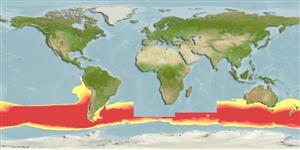>
Argentiniformes (Marine smelts) >
Microstomatidae (Pencil smelts)
Etymology: antarctica: Named for its region of occurrence.
Eponymy: Fridtjof Nansen (1861–1930) was a Norwegian explorer, scientist, diplomat and later recipient of the Nobel Peace Prize. [...] (Ref. 128868), visit book page.
Environment: milieu / climate zone / depth range / distribution range
पारिस्थितिकी
समुद्री बैथीपिलाजिक; गहराई सीमा 0 - 4145 m (Ref. 58018). Temperate
Southern Ocean: circum-Antarctic in sub-Antarctic water.
आकार / वज़न / Age
Maturity: Lm ? range ? - ? cm
Max length : 22.0 cm SL पुल्लिंग / अलिंग; (Ref. 5001)
Short description
पहचान कुंजी | आकृति विज्ञान | मौरफोमैटरिक्स
पृष्ठीय सौफट रेज़ (सम्पूर्ण) : 9 - 10; ऐनल सौफट रेज़: 9 - 10; जानवरों की रीड़ का जोड़: 47 - 50. Branchiostegal rays 3. Pyloric caeca 7. Ratio of caudal peduncle length to depth is greater than 1.5 (Ref. 5123).
The largest specimen studied, 20.75 cm SL had matured ovaries with developing eggs (Ref. 5123).
Life cycle and mating behavior
परिपक्व अवधि | पुनरुत्पत्ति | मछलीऔ का अंडे देना | अंडे | Fecundity | लार्वा
Gon, O., 1990. Microstomatidae. p. 105-106. In O. Gon and P.C. Heemstra (eds.) Fishes of the Southern Ocean. J.L.B. Smith Institute of Ichthyology, Grahamstown, South Africa. 462 p. (Ref. 5001)
IUCN Red List Status (Ref. 130435: Version 2024-1)
Threat to humans
Harmless
Human uses
साधन
Special reports
Download XML
इंटरनेट स्रोत
Estimates based on models
Preferred temperature (Ref.
123201): 1.7 - 6.4, mean 2.8 °C (based on 679 cells).
Phylogenetic diversity index (Ref.
82804): PD
50 = 0.5000 [Uniqueness, from 0.5 = low to 2.0 = high].
Bayesian length-weight: a=0.00389 (0.00180 - 0.00842), b=3.12 (2.94 - 3.30), in cm total length, based on all LWR estimates for this body shape (Ref.
93245).
Trophic level (Ref.
69278): 3.3 ±0.4 se; based on size and trophs of closest relatives
Fishing Vulnerability (Ref.
59153): Low vulnerability (17 of 100).
